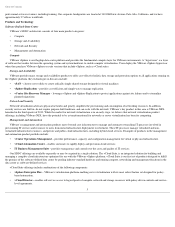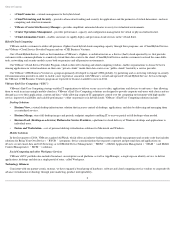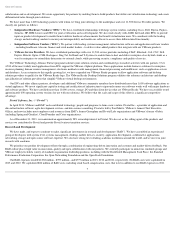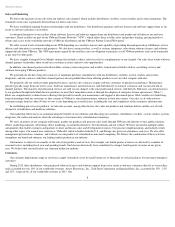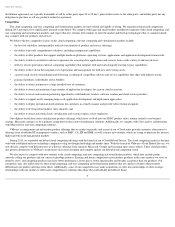VMware 2013 Annual Report Download - page 17
Download and view the complete annual report
Please find page 17 of the 2013 VMware annual report below. You can navigate through the pages in the report by either clicking on the pages listed below, or by using the keyword search tool below to find specific information within the annual report.
Table of Contents
Existing and future competitors may introduce products and services in the same markets we serve or intend to serve, and competing products and
services may have better performance, lower prices, better functionality and broader acceptance than our products and services. Our competitors may also
add features to their virtualization, end-user and cloud computing products similar to features that presently differentiate our product offerings from theirs.
Many of our current or potential competitors also have longer operating histories, greater name recognition, larger customer bases and significantly greater
financial, technical, sales, marketing and other resources than we do. This competition could result in increased pricing pressure and sales and marketing
expenses, thereby materially reducing our operating margins, and could also prevent our new products and services from gaining market acceptance, thereby
harming our ability to increase, or causing us to lose, market share. Increased competition also may prevent us from entering into or renewing service
contracts on terms similar to those that we currently offer and may cause the length of our sales cycle to increase. Additionally, some of our competitors and
potential competitors supply a wide variety of products and services to, and have well-established relationships with, our current and prospective end users.
For example, small to medium sized businesses and companies in emerging markets that are evaluating the adoption of virtualization-based technologies and
solutions may be inclined to consider Microsoft solutions because of their existing use of Windows and Office products. Some of these competitors have in
the past and may in the future take advantage of their existing relationships to engage in business practices that make our products and services less attractive
to our end users. Other competitors have limited or denied support for their applications running in VMware virtualization environments. These distribution,
licensing and support restrictions, as well as other business practices that may be adopted in the future by our competitors, could materially impact our
prospects regardless of the merits of our products and services. In addition, competitors with existing relationships with our current or prospective end users
could in the future integrate competitive capabilities into their existing products and services and make them available without additional charge. For
example, Oracle provides free server virtualization software intended to support Oracle and non-Oracle applications, and Microsoft offers its own server
virtualization software packaged with its Windows Server product and offers built-in virtualization in the client version of Windows. As a result, existing
VMware customers may elect to use products that are perceived to be “free” or “very low cost” instead of purchasing VMware products and services for
certain applications where they do not believe that more advanced and robust capabilities are required. Competitors may also leverage open source
technologies to offer zero or low cost products and services capable of putting pricing pressure on our own product offerings. By engaging in such business
practices, our competitors can diminish competitive advantages we may possess by incentivizing end users to choose products that lack some of the technical
advantages of our own offerings. In addition, even if customers find our products and services to be technically superior, they may choose to employ a “
multiple-vendor ” strategy, where they purposely deploy multiple vendors in their environment in order to prevent any one vendor from gaining too much
control over their IT operations.
We also face potential competition from our partners. For example, third parties currently selling our products and services could build and market their
own competing products and services or market competing products and services of other vendors. If we are unable to compete effectively, our growth and
our ability to sell products and services at profitable margins could be materially and adversely affected, which could materially and adversely impact our
financial condition and results of operations.
Industry alliances or consolidation may result in increased competition.
Some of our competitors have made acquisitions and entered into or extended partnerships or other strategic relationships to offer more comprehensive
virtualization and cloud computing solutions than they individually had offered. Citrix Systems continues to invest in desktop virtualization marketing by
continuing its close collaboration with Microsoft and has acquired smaller players like Zenprise, Virtual Computer and Framehawk. Moreover, information
technology companies are increasingly seeking to deliver top-to-bottom IT solutions to end users that combine enterprise-level hardware and software
solutions to provide an alternative to our virtualization platform. For example, Oracle offers integrated hardware and software virtualization
15
• the ability to deliver an intuitive end-user experience for accessing data, applications and services from a wide variety of end-
user devices;
•
the ability to effectively run traditional IT applications and emerging applications;
•
the proven track record of formulating and delivering a roadmap of virtualization and cloud computing capabilities;
•
the ability to attract and preserve a large installed base of customers;
•
pricing of products and services, individually and in bundles;
•
the ability to attract and preserve a large number of application developers to develop to a given cloud ecosystem;
•
the ability to create and maintain partnering opportunities with hardware vendors, infrastructure software vendors and cloud service providers;
•
the ability to develop robust indirect sales channels; and
•
the ability to attract and retain cloud, virtualization and systems experts as key employees.


